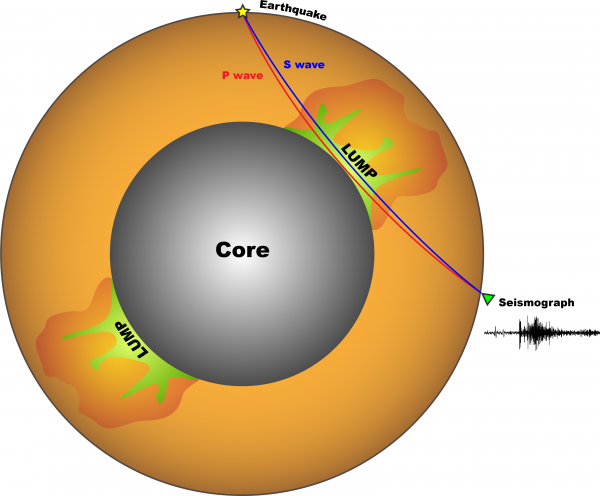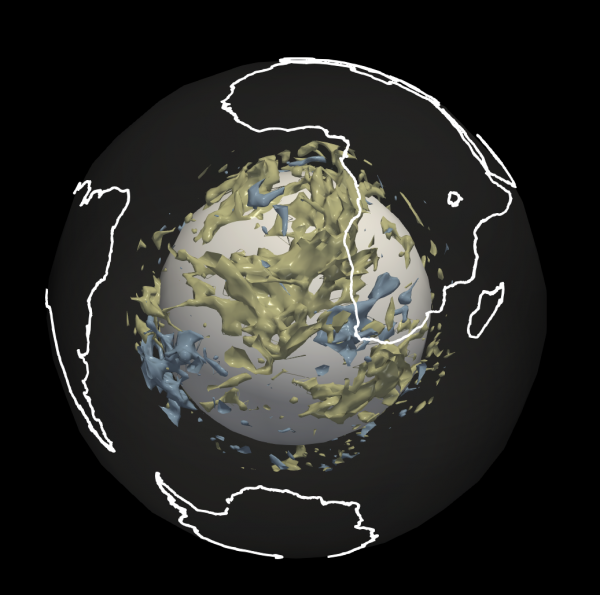A new analysis sheds light on large regions above the core detected as irregular changes in seismic wave behaviour that have remained hidden until now. The unique signature of what the authors call “Large Uncorrelated Moduli Provinces” (LUMPs) indicates the presence of rocks with distinct chemical compositions that may have been preserved for billions of years. Further investigation of LUMPs using larger volumes of seismic data collected via machine learning algorithms is planned to elucidate Earth’s formation and evolution using deep seismic imaging.

Under persistent large-scale stress, rocks inside the Earth’s mantle slowly deform and release heat from the deep interior to the surface. Because this mantle convection is sluggish, geophysicists hypothesise the existence of a poorly mixed mantle, wherein distinct chemical composition domains persist across different regions. The pattern of seismic waves generated by earthquakes and recorded by seismographs around the world may be analysed to image and interpret these features. There are two kinds of seismic waves: shear (S) waves and compressional (P) waves. Each of these is sensitive to different physical properties; leveraging these differences enables the identification of coupled S and P variations that cannot be explained by temperature variations alone.
A new study published in the Geophysical Journal International, led by researchers from the Earth-Life Science Institute (ELSI), including Jun Su, Christine Houser, and John Hernlund, has successfully identified the compositional distinction within the deep mantle by employing a technique called “tomographic filtering” to investigate resolution differences. This study utilised the supercomputer TSUBAME3.0 at the Tokyo Institute of Technology to compute the resolution of joint P and S velocity models for the first time. The results suggest that the decoupled velocity anomaly, accounting for up to 1% of the mantle, cannot be explained solely by resolution differences but requires a difference in chemical composition.
Additionally, this study provides new insights into mantle velocity structure by considering decoupled velocities in relation to elastic moduli. Specifically, it highlights the reduction of shear modulus relative to bulk modulus as the cause for the relative change in velocities. The study defines regions with significant decoupled velocities as Large Uncorrelated Moduli Provinces (LUMPs) and identifies their geographical locations. The “positive LUMPs”, with predominantly positive values, correspond to the anomaly beneath Africa and the Pacific Ocean, demonstrating a detailed structure and accounting for the compositional distinction. This is because the relative change cancels out the influence of temperature on elastic moduli. These results can also be compared with the outcomes of mantle circulation models to constrain geodynamics and enhance our understanding of Earth’s evolution.

| Journal | Geophysical Journal International |
| Title of the paper | Tomographic filtering of shear and compressional wave models reveals uncorrelated variations in the lowermost mantle |
| Authors | Jun Su 1,2*, Christine Houser 1, John W. Hernlund 1,2, and Frédéric Deschamps3 |
| Affiliations | 1. Earth-Life Science Institute, Tokyo Institute of Technology, Tokyo 152-8551, Japan 2. Department of Earth and Planetary Science, Tokyo Institute of Technology, Tokyo 152-8551, Japan 3. Institute of Earth Sciences, Academia Sinica, Taipei 11529, Taiwan |
| DOI | https://doi.org/10.1093/gji/ggad190 |
| Online published date | 18 May 2023 |
